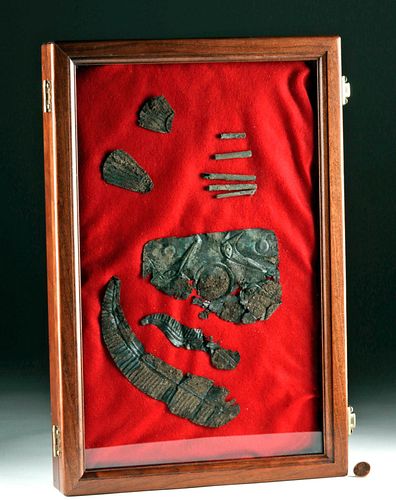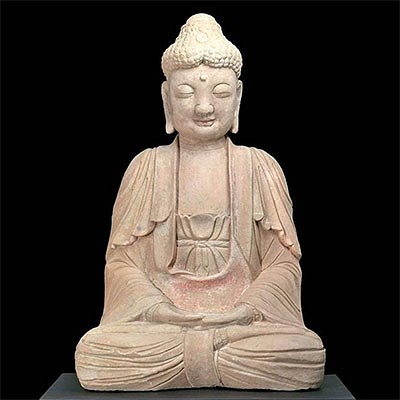Hopewell Indian Copper Feathers & Beads Group
Lot 142
About Seller
Artemis Gallery
686 S Taylor Ave, Ste 106
Louisville, CO 80027
United States
Selling antiquities, ancient and ethnographic art online since 1993, Artemis Gallery specializes in Classical Antiquities (Egyptian, Greek, Roman, Near Eastern), Asian, Pre-Columbian, African / Tribal / Oceanographic art. Our extensive inventory includes pottery, stone, metal, wood, glass and textil...Read more
Categories
Estimate:
$6,000 - $8,000
Absentee vs Live bid
Two ways to bid:
- Leave a max absentee bid and the platform will bid on your behalf up to your maximum bid during the live auction.
- Bid live during the auction and your bids will be submitted real-time to the auctioneer.
Bid Increments
| Price | Bid Increment |
|---|---|
| $0 | $25 |
| $300 | $50 |
| $1,000 | $100 |
| $2,000 | $250 |
| $5,000 | $500 |
| $10,000 | $1,000 |
| $20,000 | $2,500 |
| $50,000 | $5,000 |
| $100,000 | $10,000 |
| $200,000 | $20,000 |
About Auction
By Artemis Gallery
Feb 18, 2021
Set Reminder
2021-02-18 10:00:00
2021-02-18 10:00:00
America/New_York
Bidsquare
Bidsquare : Exceptional Antiquities, Asian, Ethnographic
https://www.bidsquare.com/auctions/artemis-gallery/exceptional-antiquities-asian-ethnographic-6373
Museum-worthy examples of Egyptian, Greek, Roman, Etruscan, Near Eastern, Far East / Asian, Pre-Columbian, African / Tribal, Oceanic, Native American, Spanish Colonial, Russian, Fossils, Ancient Jewelry, Fine Art, so much more! Artemis Gallery info@artemisgallery.com
Museum-worthy examples of Egyptian, Greek, Roman, Etruscan, Near Eastern, Far East / Asian, Pre-Columbian, African / Tribal, Oceanic, Native American, Spanish Colonial, Russian, Fossils, Ancient Jewelry, Fine Art, so much more! Artemis Gallery info@artemisgallery.com
- Lot Description
Native American, central North America, Ohio, Hopewell Indians, ca. 100 BCE to 500 CE. An exceedingly-rare group of ornaments formed from extremely-delicate sheets of copper foil and decorated with repousse details. Five tubular beads have slender profiles formed by wrapping a small copper sheet around a thin mold, and a small pair of feathers have minute attachment piercings on the smaller ends. Two larger feathers each feature dozens of petite ridges indicative of individual barbs. The largest applique is oblong in form and exhibits abstract monocular birds, each with a large aquiline beak above a small ball, and all surrounding a central orb. Ornamentation like these examples were perhaps used to adorn necklaces, various bodily decorations, and elaborate headdresses. Thick layers of brown patina envelop each component, though scattered areas of blue-green, green, and azurite patina are visible. Custom fabric-lined display case included. Size of largest (birds): 5.75" W x 3.8" H (14.6 cm x 9.7 cm); size (frame): 12" W x 17.8" H (30.5 cm x 45.2 cm).
For additional information on the Hopewell Indians and their use of stone and copper in their artistic creations, please see The Heilbrunn Timeline of Art History (Department of the Arts of Africa, Oceania, and the Americas. "Hopewell (1-400 A.D.)." In Heilbrunn Timeline of Art History. New York: The Metropolitan Museum of Art, 2000-. https://www.metmuseum.org/toah/hd/hope/hd_hope.htm)
Provenance: private southwestern Pennsylvania, USA collection, acquired prior to 2000
All items legal to buy/sell under U.S. Statute covering cultural patrimony Code 2600, CHAPTER 14, and are guaranteed to be as described or your money back.
A Certificate of Authenticity will accompany all winning bids.
We ship worldwide and handle all shipping in-house for your convenience.
#144639Losses, nicks, and bending commensurate with age and fragility as shown. Softening to some repousse details, light encrustations, and losses to peripheries of tube beads and some appliques. Light earthen deposits and nice brown patina throughout. Scattered areas of green, blue-green, and azurite patina visible.Condition
- Shipping Info
-
All shipping is handled in-house for your convenience. Your invoice from Artemis Gallery will include shipping calculation instructions. If in doubt, please inquire BEFORE bidding for estimated shipping costs for individual items.
-
- Buyer's Premium



 EUR
EUR CAD
CAD AUD
AUD GBP
GBP MXN
MXN HKD
HKD CNY
CNY MYR
MYR SEK
SEK SGD
SGD CHF
CHF THB
THB














